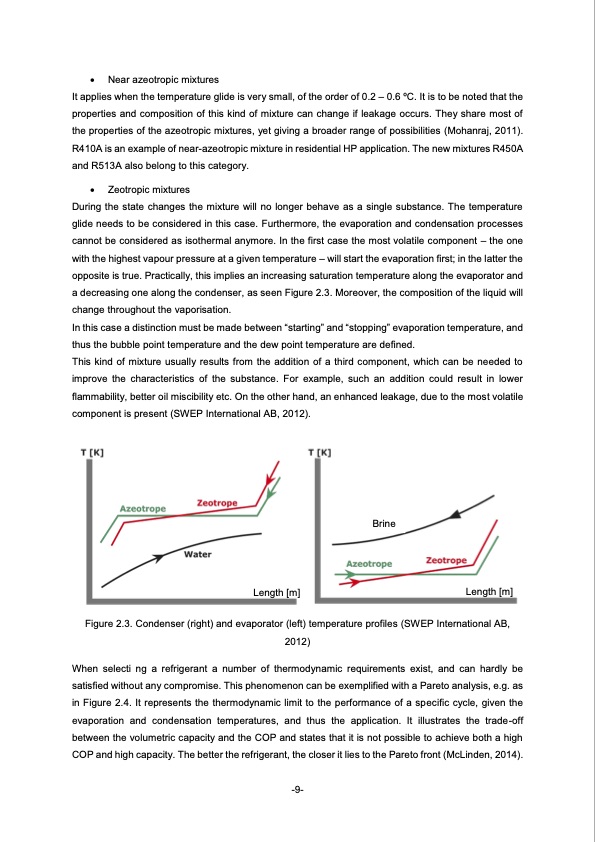
PDF Publication Title:
Text from PDF Page: 018
Near azeotropic mixtures It applies when the temperature glide is very small, of the order of 0.2 – 0.6 oC. It is to be noted that the properties and composition of this kind of mixture can change if leakage occurs. They share most of the properties of the azeotropic mixtures, yet giving a broader range of possibilities (Mohanraj, 2011). R410A is an example of near-azeotropic mixture in residential HP application. The new mixtures R450A and R513A also belong to this category. Zeotropic mixtures During the state changes the mixture will no longer behave as a single substance. The temperature glide needs to be considered in this case. Furthermore, the evaporation and condensation processes cannot be considered as isothermal anymore. In the first case the most volatile component – the one with the highest vapour pressure at a given temperature – will start the evaporation first; in the latter the opposite is true. Practically, this implies an increasing saturation temperature along the evaporator and a decreasing one along the condenser, as seen Figure 2.3. Moreover, the composition of the liquid will change throughout the vaporisation. In this case a distinction must be made between “starting” and “stopping” evaporation temperature, and thus the bubble point temperature and the dew point temperature are defined. This kind of mixture usually results from the addition of a third component, which can be needed to improve the characteristics of the substance. For example, such an addition could result in lower flammability, better oil miscibility etc. On the other hand, an enhanced leakage, due to the most volatile component is present (SWEP International AB, 2012). Length [m] Length [m] Figure 2.3. Condenser (right) and evaporator (left) temperature profiles (SWEP International AB, 2012) When selecti ng a refrigerant a number of thermodynamic requirements exist, and can hardly be satisfied without any compromise. This phenomenon can be exemplified with a Pareto analysis, e.g. as in Figure 2.4. It represents the thermodynamic limit to the performance of a specific cycle, given the evaporation and condensation temperatures, and thus the application. It illustrates the trade-off between the volumetric capacity and the COP and states that it is not possible to achieve both a high COP and high capacity. The better the refrigerant, the closer it lies to the Pareto front (McLinden, 2014). -9- BrinePDF Image | Next generation of refrigerants for residential heat pump systems

PDF Search Title:
Next generation of refrigerants for residential heat pump systemsOriginal File Name Searched:
MartinaLonghini_ThesisReport.pdfDIY PDF Search: Google It | Yahoo | Bing
CO2 Organic Rankine Cycle Experimenter Platform The supercritical CO2 phase change system is both a heat pump and organic rankine cycle which can be used for those purposes and as a supercritical extractor for advanced subcritical and supercritical extraction technology. Uses include producing nanoparticles, precious metal CO2 extraction, lithium battery recycling, and other applications... More Info
Heat Pumps CO2 ORC Heat Pump System Platform More Info
| CONTACT TEL: 608-238-6001 Email: greg@infinityturbine.com | RSS | AMP |